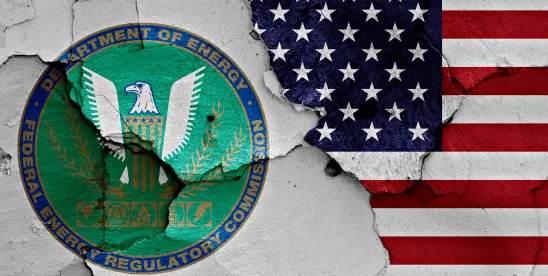The Federal Energy Regulatory Commission (“FERC” or the “Commission”) issued an Order[1] addressing the United States Court of Appeals for the District of Columbia Circuit’s (“D.C. Circuit”) second remand concerning Texas LNG Brownsville LLC’s (“Texas LNG”) proposed liquefied natural gas (“LNG”) terminal project (“Texas LNG Project”) on August 21, 2025. The Commission’s Order affirms its prior determination that the Texas LNG Project is not inconsistent with the public interest and grants Texas LNG a five-year extension of time, to November 22, 2029, to construct and make available for service the Texas LNG Project.
BACKGROUND
Proceedings Before FERC
The Texas LNG Project, authorized by the Commission on November 22, 2019, under section 3 of the Natural Gas Act (“NGA”), involves the construction and operation of an LNG export terminal, with a capacity of approximately four million metric tonnes per annum (“MTPA”). The Commission determined, based on the findings presented in the final Environmental Impact Statement (“EIS”), that construction and operation of the project, as described in the final EIS, would be an environmentally acceptable action.[2]
Vecinos para el Bienestar de la Comunidad Costera v. FERC (D.C. Cir.)
Following the initial authorization, various parties sought rehearing and judicial review, raising concerns regarding, among other things, the Commission’s analysis under the National Environmental Policy Act (“NEPA”), particularly with respect to climate impact and environmental justice.[3] The D.C. Circuit reversed and remanded FERC orders. On remand, FERC reiterated its prior determinations, which were again appealed. FERC denied rehearing.[4] Petitions for review were filed with the D.C. Circuit.
2024 Court Remand and Supplemental Environmental Review
On August 6, 2024, in Port Isabel I, the D.C. Circuit vacated and remanded the Commission’s 2023 Remand and Rehearing Orders authorizing the Texas LNG Project.[5] The Court directed the Commission to (1) issue a supplemental EIS and (2) include data from the Isla Blanca monitor in its air quality analysis or provide a new, reasoned explanation for declining to use it. The Court found that the Commission’s previous analysis failed to adequately explain why it excluded data from the Isla Blanca monitor, which had shown a potential exceedance of the National Ambient Air Quality Standards (“NAAQS”) for fine particulate matter during the study period. Subsequently, in Port Isabel II, the D.C. Circuit determined the Commission’s procedural omissions did not warrant vacatur but remanded the case to the Commission to address these procedural deficiencies.[6] The D.C. Circuit declined to assess the impact of two executive orders issued in January 2025—Executive Order 14,713,[7] which revoked Executive Order 12,898[8] that requires federal agencies to identify and mitigate impacts on environmental justice communities and Executive Order 14,514,[9] which prohibits agencies from “weigh[ing] any environmental considerations except those expressly provided by statute.”
Consistent with the Court’s directives, the Commission issued a final supplemental EIS incorporating the Isla Blanca monitor data into the air quality analysis and expanding the scope of the environmental justice review to include all communities within the area of potential impact.
- Air Quality Analysis
The Commission has adopted a three-step process to evaluate a project’s potential air quality impacts. The three-step process is as follows:
- Step One—Preliminary Screening: The project’s potential emissions are modeled and compared to EPA’s Significant Impact Levels (“SILs”) for each criteria pollutant and averaging period (e.g., one-hour, eight-hour, 24-hour, or annual) to determine if the project’s emissions exceed the SIL. If the predicted impacts for a particular criteria pollutant are below the applicable SIL, no further analyses or modeling are required.
- Step Two—Full Cumulative Impact Analysis: Each criteria pollutant that exceeds the SIL for a specific averaging period in Step One is modeled individually using a cumulative analysis that considers emissions from existing regional sources in addition to the project’s modeled emissions (including data from the Isla Blanca monitoring station) at any receptor location.
- Step Three—Cause and Contribute Analysis: If the cumulative modeling predicts NAAQS exceedance, then the state permitting agency evaluates whether the project’s specific contribution at the location and time of the exceedance is above or below the SIL. If the project’s contribution is below the SIL, it is considered not to have caused or contributed to the exceedance and the state agency may issue the permit.
Here, Texas LNG provided for Commission review a Step Two cumulative impact analysis for each criteria pollutant, not just those that exceeded the SIL for the averaging period. The results from the cumulative impact analysis showed NAAQS exceedances for only 24-hour and annual inhalable particulate matter with an aerodynamic diameter less than or equal to 2.5 micrometers (PM2.5). Accordingly, the Commission found that the project would not cause or contribute to the exceedance and would not have a significant impact on regional air quality. The Commission further reiterated that using NAAQS as the standard for evaluating air quality impacts under NEPA has been held by courts to be a reasonable methodology.
- Environmental Justice
The Commission concluded that approval of the project would result in less than significant impacts on local communities with implementation of the environmental conditions set forth in its prior authorizations of the project. Although the supplemental EIS provided an updated and expanded analysis of potential disproportionate and adverse impacts on environmental justice communities, the Commission clarified that this analysis was provided for informational purposes only, as it is not obligated to consider these impacts in its NEPA documents or decisions, pursuant to Executive Orders 14,154 and 14,173. Finally, the Commission found that, with implementation of mitigation measures, project impacts on local communities, including those with environmental justice concerns, would be less than significant, except for certain visual impacts.
In reaching its determination, FERC rejected arguments that its past interpretation of its NEPA obligations continue to be binding regardless of the executive orders, noting that the Council for Environmental Quality (“CEQ”) has rescinded its regulations, making them inoperative, and the D.C. Circuit had also found them ultra vires.[10] Moreover, FERC stated that it had made this clear when it removed from its own regulations references to the defunct CEQ regulations. FERC applied the directives in the executive orders in reaching its conclusions, but provided the information ordered by the court for informational purposes only.
CONCLUSION
The Commission Order affirms that the Texas LNG Project remains an environmentally acceptable action and is not inconsistent with the public interest, subject to compliance with the environmental conditions set forth in the Commission’s prior and current orders. Further administrative and judicial review is likely; however, the fact that the Commission elected to address directly environmental justice concerns as specified by the court (albeit as a matter of “information”) seems to call into question the issue of whether potential petitioners seeking to challenge these executive orders in this proceeding would have the actual aggrievement necessary to sustain standing because the orders on review explain why FERC’s actions were consistent with both prior and current executive policy.
[1]Texas LNG Brownsville LLC, 192 FERC ¶ 61,170 (2025).
[2] Authorization Order, 169 FERC ¶ 61,130 at P 86.
[3] Vecinos Groups Dec. 23, 2019 Request for Rehearing and Stay at 14-22.
[4] 2020 Rehearing Order, 170 FERC ¶ 61,139.
[5]Port Isabel I, 111 F.4th 1198 (2024).
[6]Port Isabel II, 130 F.4th 1034 (2025).
[7] Exec. Order No. 14,173, 90 Fed. Reg. 8633, 8634 (Jan. 21, 2025).
[8] Exec. Order No. 12,898, 59 Fed. Reg. 7629 (Feb. 16, 1994).
[9] Exec. Order No. 14,154, 90 Fed Reg. 8353, 8356 (Jan. 20, 2025).
[10] Citing Marin Audubon Soc’y v. Fed. Aviation Admin., 121 F.4th 902 (D.C. Cir. 2024), reh’g denied en banc, No. 23-1067, 2025 WL 374897 (D.C. Cir. Jan. 31, 2025).




 />i
/>i
